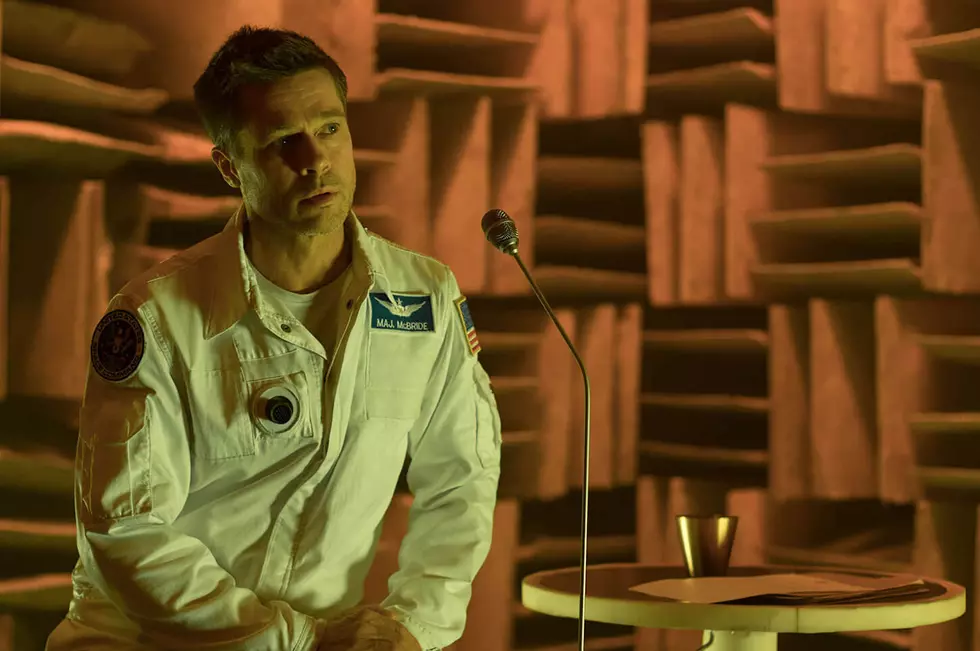
‘Ad Astra’ Review: A Movie Star, In Orbit Around His Dad
Pundits confidently assert we live in an era without movie stars, a notion Brad Pitt appears to want to single-handedly destruct with the year he’s having in 2019. Having conquered Earth acting in Once Upon a Time in Hollywood, Brad Pitt now gives space acting a try in Ad Astra. In this film, Pitt plays one of only two major roles — and the other major role is a possibly dead guy on the other side of the galaxy. For 124 minutes, Ad Astra is The Brad Pitt Show™. For 124 minutes, it’s a damn good show.
The trailers for Ad Astra effectively convey the contours of the drama without revealing many of its particulars. I will try to follow the same course. It’s no spoiler to say the hero of the film is a brave astronaut named Roy McBride (Pitt). In the near future, Roy is chosen for a mission of planetary importance. Something in deep space is emitting an energy pulse that is causing worldwide blackouts. As these pulses grow stronger, they threaten to destroy civilization. So it’s up to Roy to head to the edge of the Solar System, find the cause of the problem, and shut it down.
Roy shares a personal connection to the problem. His father, Cliff McBride (Tommy Lee Jones), was the last man to venture out to the area where the pulses are coming from. Cliff is widely regarded as the greatest astronaut in our nation’s history. When Roy was still a teenager, Cliff left on a mission to find proof of alien life in the universe. He never returned. Although Cliff has been presumed dead since then, Roy’s bosses in “SpaceCom” believe he may be behind the pulses, or at least know their origin. They hope a talk with his son might help resolve the issue. (Suggested tagline for the film: “In space, no one can hear you cry for your dad.”)
Roy’s quest gives director James Gray, who co-wrote the film with Ethan Gross, the chance to explore the world of the near future. His first stop is the Moon, which is full of corporate sponsorship, malls, and dastardly pirates fighting over precious mining resources — leading to a surreal and surprisingly intense chase between lunar rovers. From there, Roy visits other planets and distant Earth outposts. They offer opportunities for further considerations of how adaptable mankind and its communities may be to the bleak void of space — along with more intense action sequences. Although Pitt provides a hushed, poetic voiceover throughout the film, this isn’t quite the Malickian art film you may have expected from the trailers. Or at least the Malickian art film within it is often interrupted by bursts of violence and danger, and supported by impressive digital effects.
Roy’s quest also gives Gray the excuse to focus his camera on Pitt at his most contemplative. As stuntman Cliff Booth in Once Upon a Time in Hollywood, Pitt was a swaggering modern cowboy; fearless, ferocious, and utterly unflappable. In Ad Astra, he plays a hero of a less sturdy sort. In a hairy situation, he’s still quick to act. After the danger passes, though, he’s prone to introspection, sadness, and regret, particularly over the absence of his former wife (played by Liv Tyler). Roy’s superiors note that they’ve never recorded him with an elevated pulse rate, and playing someone that stoic in a way that’s not boring to watch requires, well, a movie star. Pitt pulls it off, making Roy a man who’s so completely bottled up that when he finally allows the tiniest bit of emotion to escape, it’s like someone dropped a Mentos into a Diet Coke.
Roy’s quest to find his dad is very similar in both theme and message to Gray’s last film, The Lost City of Z. It was based on the true story of explorer Percy Fawcett (Charlie Hunnam) who went missing in the jungles of South America in the 1920s. Like Fawcett, Cliff McBride is a man consumed with searching the furthest reaches of the known universe for proof of the existence of unknown civilizations. In both movies, Gray is sympathetic to these restless men and their passions, but he also weighs any discoveries they make against the sacrifices they also make to find those discoveries. Their journeys take a heavy toll on their families, and in large part Gray tells their stories through the eyes of those who’ve been left behind. In Lost City, that was Fawcett’s wife Nina (Sienne Miller). In Ad Astra, that’s Roy.
While Gray may have told basically this same story before, Ad Astra’s cosmic setting makes it even more poignant, because it puts into such sharp relief how small each of us is against the vastness of space, and how our time in that space is the most finite blip possible when compared with the totality of cosmic history. Look past the trappings of rocket ships and alien life, and the thing that comes up the most in Ad Astra is the concept of time. How long it’s been since Cliff left Earth; how long Roy has tried to follow in his footsteps; how long it takes to get from the Earth to the Moon, or from the Moon to Mars — and how brief all of those spans are when juxtaposed against the infinite.
You don’t need to have survived a lunar module chase to relate to Roy and Cliff’s story. Ad Astra’s setting may be on the exotic side, but at its core this is a simple conflict that almost every parent or child will recognize as their own. Human beings are torn between their hunger to make an impact on that cosmic history, and their connection to the real legacy they leave behind, their children. Pitt, who is the father of six children himself, understands that conflict as well as anyone.
Gallery — 18 Times Actors Transformed Themselves For a Role:
More From 98.7 Kiss FM










